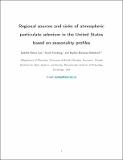Regional Sources and Sinks of Atmospheric Particulate Selenium in the United States Based on Seasonality Profiles
Author(s)
Lao, Isabelle Renee; Feinberg, Aryeh; Borduas-Dedekind, Nadine
DownloadLao_accepted.pdf (11.85Mb)
Open Access Policy
Open Access Policy
Creative Commons Attribution-Noncommercial-Share Alike
Terms of use
Metadata
Show full item recordAbstract
Selenium (Se) is an essential nutrient for humans and enters our food chain through bioavailable Se in soil. Atmospheric deposition is a major source of Se to soils, driving the need to investigate the sources and sinks of atmospheric Se. Here, we used over 20 years (from 1988 to 2010) of Se concentrations from PM2.5 data at 82 sites from the Interagency Monitoring of Protected Visual Environments (IMPROVE) network in the US to identify the sources and sinks of particulate Se. We identified 6 distinct seasonal profiles of atmospheric Se, grouped by geographical location: West, Southwest, Midwest, Southeast, Northeast, and North Northeast. Coal combustion is the most important Se source, with a terrestrial source dominating in the west. We also found evidence for gas-to-particle partitioning in the wintertime in the Northeast. Wet deposition is an important sink of particulate Se, as determined by Se/PM2.5 ratios. The Se concentrations from the IMPROVE network compare well to modeled output from a global chemistry-climate model, SOCOL-AER, except in the Southeast US. Our analysis constrains the sources and sinks of atmospheric Se, thereby improving the predictions of Se distribution under climate change.
Date issued
2023-05-05Department
Massachusetts Institute of Technology. Institute for Data, Systems, and SocietyJournal
Environmental Science & Technology
Publisher
American Chemical Society (ACS)
Citation
Environ. Sci. Technol. 2023, 57, 19, 7401–7409.
Version: Author's final manuscript
ISSN
0013-936X
1520-5851
Keywords
Environmental Chemistry, General Chemistry